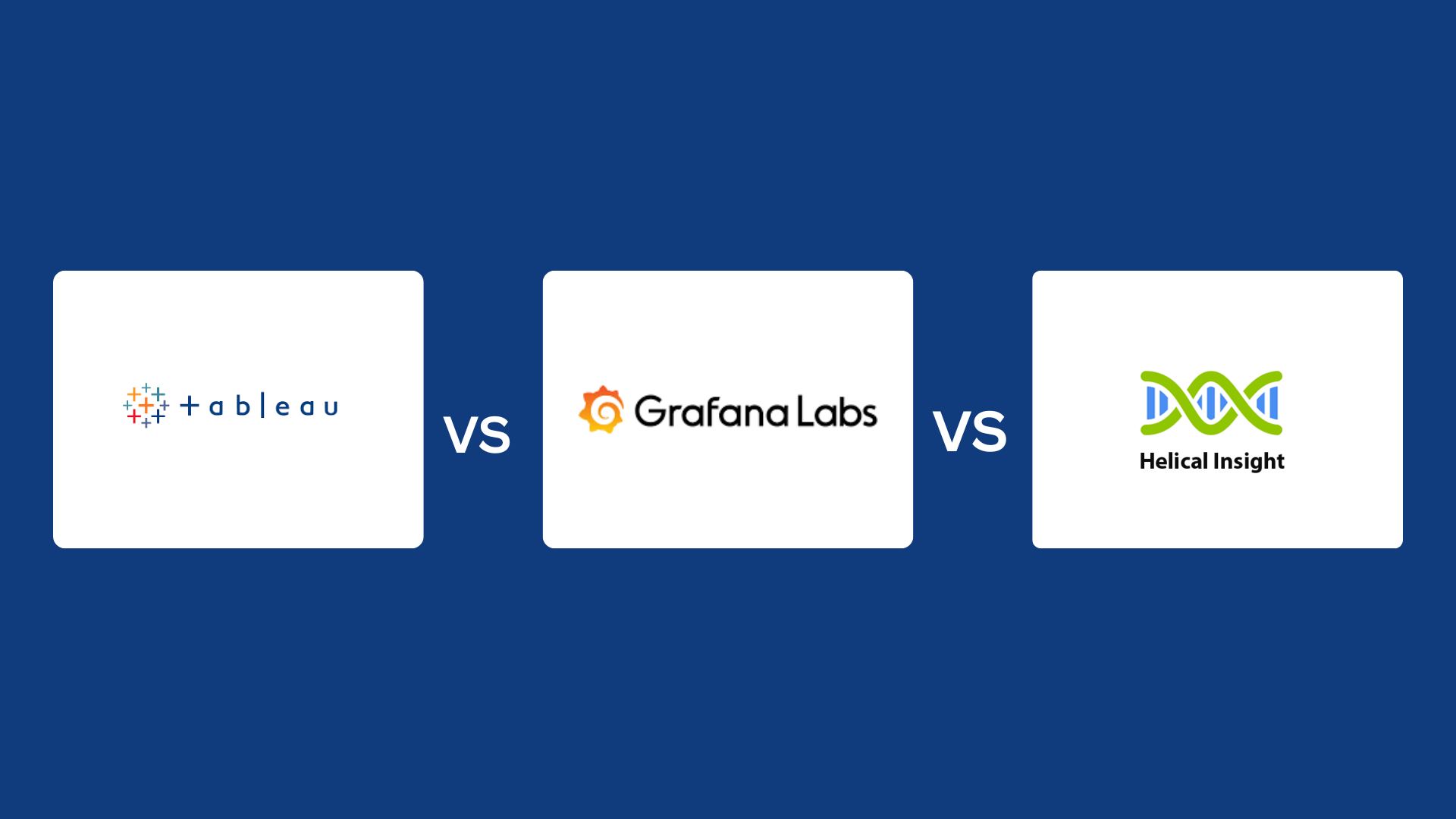
In 2025, data-driven decision-making is no longer optional—it’s a necessity. From startups to global enterprises, organizations are adopting Business Intelligence (BI) tools to visualize data, generate insights, and make faster business decisions. But with so many options, the challenge lies in choosing the right BI tool.
Among the most discussed names are Tableau, Grafana, and Helical Insight. Each has its strengths:
- Tableau is widely known for polished dashboards and ease of use,
- Grafana dominates in real-time monitoring and DevOps analytics,
- Helical Insight shines as an open-source, highly customizable BI platform with enterprise-grade reporting.
This blog provides a detailed feature-by-feature comparison of Tableau, Grafana, and Helical Insight—covering pricing, usability, customization, extensibility, deployment, reporting, and use cases. If you are searching for a Tableau alternative, Grafana replacement, or the best open-source BI tool for 2025, this guide will help you make the right choice.
🚀 Move Beyond Tableau and Grafana Limitations
✨ Experience Helical Insight — the open-source BI platform with flat pricing, pixel-perfect reporting, and enterprise flexibility.
Feature Comparison: Tableau vs Grafana vs Helical Insight
| Feature | Tableau | Grafana | Helical Insight ⭐ |
|---|---|---|---|
| Pricing | High per-user licensing, premium add-ons | Free open-source core, enterprise version for advanced features | Flat pricing + Free Community Edition (open-source) |
| Ease of Use | Drag-and-drop, great for non-technical users | Requires technical skills, best for engineers | Drag-drop + scripting + self-service BI |
| Customization | Limited APIs, vendor lock-in risk | Strong in monitoring plugins, weak in BI workflows | Highly extensible – APIs, workflow engine, embedding, scripting |
| Deployment | Cloud + On-premise (expensive at scale) | Open-source, cloud & self-host | Both on-prem & cloud, open-source flexibility |
| Reporting Styles | Dashboards, storytelling, pixel-perfect reports | Time-series charts, metrics, alerts | Dashboards, pixel-perfect, canned reports, workflows |
| Extensibility | Moderate – Tableau Extensions Marketplace | Strong plugin ecosystem for monitoring | Very high – developer customization, cross-database joins |
| Support | Paid enterprise support, high cost | Community + enterprise support available | Direct vendor support + active community |
| Best For | Business users & enterprises with budget | DevOps, monitoring, engineering dashboards | Enterprises, startups, embedded BI, open-source BI |
Deep Dive Into Each Tool
🔹 Tableau
Tableau has long been the poster child of business intelligence. Its intuitive drag-and-drop interface makes it ideal for business analysts, managers, and executives who need quick insights without writing queries.
Strengths:
- Polished and interactive dashboards
- Extensive learning community and documentation
- Seamless integration with many databases and apps
- Great for data storytelling and executive presentations
Limitations:
- Pricing model is per-user, which gets very expensive as teams scale
- Limited extensibility (APIs are restricted, vendor lock-in risk)
- Advanced custom workflows and embedding are difficult
- Heavier infrastructure cost for on-premise deployment
🔹 Grafana
Grafana is a monitoring-first analytics platform, originally built for DevOps teams. It excels at real-time dashboards, time-series data, and system monitoring.
Strengths:
- Free and open-source at its core
- Rich plugin ecosystem for metrics, logs, and tracing
- Ideal for IT monitoring, server metrics, and IoT dashboards
- Can connect with Prometheus, ElasticSearch, InfluxDB, and more
Limitations:
- Not a complete BI tool—designed for observability, not business reporting
- No pixel-perfect reporting or advanced business workflows
- Requires strong technical expertise to build queries and dashboards
- Limited enterprise BI features compared to Tableau and Helical Insight
🚀 Move Beyond Tableau and Grafana Limitations
✨ Experience Helical Insight — the open-source BI platform with flat pricing, pixel-perfect reporting, and enterprise flexibility.
🔹 Helical Insight
Helical Insight is a modern, open-source BI platform that combines enterprise reporting, self-service analytics, and deep customization. Unlike Tableau’s per-user cost or Grafana’s monitoring-first design, Helical Insight provides flexible BI for all use cases.
Strengths:
- Free open-source community edition + flat enterprise pricing
- Full spectrum reporting: dashboards, ad-hoc, pixel-perfect, canned reports, workflows
- Highly extensible: APIs, scripting, embedding, developer customization
- Supports cross-database joins, workflow automation, and embedded analytics
- Direct vendor support + active open-source community
Limitations:
- Learning curve for advanced customization
- Smaller brand recognition compared to Tableau
Pros & Cons at a Glance
|
Tableau
✅ Intuitive UI |
Grafana
✅ Free core version |
Helical Insight
✅ Open-source + flat pricing |
Conclusion
When comparing Tableau vs Grafana vs Helical Insight, it’s clear each tool has its niche. Tableau is best for polished business dashboards, Grafana for monitoring, and Helical Insight for flexible, cost-effective, open-source BI with enterprise-grade features.
If you’re searching for the best Tableau alternative or a Grafana replacement for full BI, Helical Insight stands out as the most versatile BI tool in 2025.
👉 Ready to explore a BI platform that offers flat pricing, open-source flexibility, and enterprise features?
Try Helical Insight and transform the way your business works with data.
